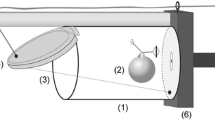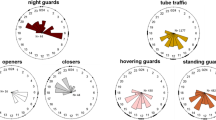Summary
Xylocopa pubescens is a facultatively social species in which two types of guards can be found: 1) old, formerly reproductive guards and 2) young, pre-reproductive guards that usually guard the nest in which they emerged. In this species it is always the dominant female that forages and lays the eggs.
This paper focuses on the young females' reasons for guarding. Young guards are characteristically the first females of an emerging brood. They start guarding at an age of 6 days, and continue to do so for on average 10 days, when they start a dominance contest. In comparison to other emerging bees, guards did not receive any more of the incoming food. The presence of young females in the nest was sufficient to deter pollen robbers; the protection was not ameliorated by guarding. Guards did not protect the nest from usurpation by intruding females. The presence of a young guard positively influenced both the number and the duration of foraging flights.
All guards attempted to take over dominance inside the nest by fighting with the dominant female. Guards had a probability of 50% of winning this contest, which was distinctly higher than their probability of finding a nest elsewhere. The dominant female was not in all cases the mother of the guard. Therefore, the average increase of indirect fitness by guarding was lower than the expected direct fitness returns from leaving the nest earlier. We therefore conclude that guarding females are environmentally disabled, hopeful reproductives. They may be guarding to determine the right time to risk a fight about dominance and to increase their direct fitness if their attempt to supersede is successful.
Similar content being viewed by others
References
Anzenberger, G., 1986. How do carpenter bees recognize the entrance of their nests? An experimental investigation in a natural habitat.Ethology 71:54–62.
Ben Mordechai, Y., R. Cohen, D. Gerling and E. Moscovitz, 1978. The biology ofXylocopa pubescens (Spinola) (Hymenoptera: Anthophoridae) in Israel,Isr. J. Entomol. 12:107–121.
Blom, J. van der and H. H. W. Velthuis, 1988. Social behaviour of the carpenter beeXylocopa pubescens (Spinola).Ethology 79:281–294.
Bonelli, B., 1976. Osservationi eto-ecologiche sugli Imenotteri aculeati dell'Etiopia. VII.Xylocopa (Mesotrichia) combusta Smith (Hymenoptera-Anthrophoridae).Boll. Entomol. Bologna 33:1–31.
Camillo, E. and C. A. Garófalo, 1989. Social organization in reactivated nests of three species ofXylocopa (Hymenoptera, Anthophoridae) in Southeastern Brasil.Ins. Soc. 36:92–105.
Cruden, R. W., 1966. Observations on the behavior ofXylocopa c. California andX. tabaniformis orpifex.Pan-Pac. Entomol. 42:111–119.
Emlen, S. T. and P. H. Wrege, 1989. A test of alternative hypotheses for the helping behavior in white-fronted bee-eaters in Kenya.Behav. Ecol. Sociobiol. 25:305–319.
Gerling, D., H. H. W. Velthuis and A. Hefetz, 1989. Bionomics of the large carpenter bees of the genusXylocopa.Ann. Rev. Entomol. 34:163–190.
Gerling, D., P. D. Hurd Jr. and A. Hefetz, 1981. In-nest behavior of the carpenter bee,Xylocopa pubescens Spinola (Hymenoptera: Anthophoridae).Jour. Kans. Entomol. Soc. 54(2):209–218.
Hefetz, A., D. Mevoreh and D. Gerling, 1990. Nest recognition by scent in the carpenter beeXylocopa pubescens. In:Social insects and the environment (G. K. Veeresh, B. Mallik and C. A. Viraktamath, Eds.), Proceedings of the llth International Congress of IUSSI. p. 515.
Hogendoorn, K. and H. H. W. Velthuis, 1993. The sociality ofXylocopa pubescens: Does a helper really help?Behav. Ecol. Sociobiol. 32:247–257.
Hogendoorn, K. and R. Leys, 1993. The superseded female's dilemma: factors that influence guarding behavior of the carpenter beeXylocopa pubescens.Behav. Ecol. Sociobiol. 33:271–381.
Hurd Jr., P. D., 1958. Observations on the nesting habits of some new world carpenter bees with remarks on their importance in the problem of species formation (Hymenoptera: Apoidea).Ann. Entomol. Soc. Am. 51:365–375.
Klahn, J. E. and G. J. Gamboa, 1983. Social Wasps: discrimination between kin and nonkin brood.Science 221:482–484.
MacDonald, J. and R. W. Matthews, 1975.Vespula squamosa: a yellow jacket wasp evolving towards parasitism.Science 190:1003–1004.
Malyshev, S. J., 1931. Lebensgeschichte der Holzbienen,Xylocopa Latr. (Apoidea).Z. Morphol. Okol. Tiere 23:754–809.
Michener, C. D. and D. J. Brothers, 1974. Were workers of eusocial Hymenoptera initially altruistic or oppressed?Proc. Nat. Acad. Sci. 71:671–674.
O'Keefe, K. J. and M. P. Schwarz, 1990. Pheromones are implicated in reproductive differentiation in a primitively social bee.Naturwissenschaften 77:83–86.
Owens, D. D. and M. J. Owens, 1984. Helping behavior in brown hyenas.Nature 308:843–845.
Packer, C., L. Herbst and A. E. Pusey, 1988. Reproductive success in lions. In:Reproductive success: Studies of individual variation in contrasting breeding systems (T. H. Clutton-Brock, Ed.). University of Chicago Press, pp. 363–383.
Packer, L. and R. E. Owen, 1994. Relatedness and sex ratio in a primitively eusocial halictine bee.Behav. Ecol. Sociobiol. 34:1–10.
Reyer, H.-U., 1990. Pied kingfishers: ecological causes and reproductive consequences of cooperative breeding. in:Cooperative breeding in birds: long-term studies of ecology and behavior (P. B. Stacey and W. D. Koenigs, Eds.), Cambridge Univ. Press, Cambridge, UK, pp. 527–557.
Schwarz, M. P., 1986. Persistent multifemale nests in an Australian allodapine beeExoneura bicolor.Ins. Soc. 33:258–277.
Schwarz, M. P., 1994. Female biased sex ratios in a facultatively social bee and their implications for social evolution.Evolution 48:1684–1697.
Smith, B. H. and C. Weller, 1989. Social competition among gynes in halictine bees: The influence of bee size and pheromones on behavior.J. Ins. Behav. 2:397–411.
Stark, R. E., 1992. Cooperative nesting in the multivoltine large carpenter beeXylocopa sulcatipes Maa (Apoidea: Anthophoridae): Do helpers gain or lose to solitary females?Ethology 91:301–310.
Strassmann, J. E. and D. C. Queller, 1989. Ecological determinants of social evolution. In:The genetics of social evolution (M. D. Breed and R. E. Page, Eds.), Westview Press, Boulder, Colorado, pp. 81–101.
Velthuis, H. H. W. and D. Gerling, 1983. At the brink sociality: Interactions between adults of the carpenter beeXylocopa pubescens Spinola.Behav. Ecol. Sociobiol. 12:209–214.
Velthuis, H. H. W., 1987. The evolution of sociality: ultimate and proximate factors leading to primitive social behavior in carpenter bees.Experientia Suppl. 54:405–430.
West-Eberhard, M. J., 1978. Temporary queens inMetapolybia wasps: non-reproductive helpers without altruism?Science 200:441–443.
Yanega, D., 1989. Caste determination and differential diapause within the first brood ofHalictus rubicundus in New York (Hymenoptera: Halictidae).Behav. Ecol. Sodobiol. 24:97–107.
Author information
Authors and Affiliations
Rights and permissions
About this article
Cite this article
Hogendoorn, K., Velthuis, H.H.W. The role of young guards inXylocopa pubescens . Ins. Soc 42, 427–448 (1995). https://doi.org/10.1007/BF01242171
Received:
Revised:
Accepted:
Issue Date:
DOI: https://doi.org/10.1007/BF01242171




